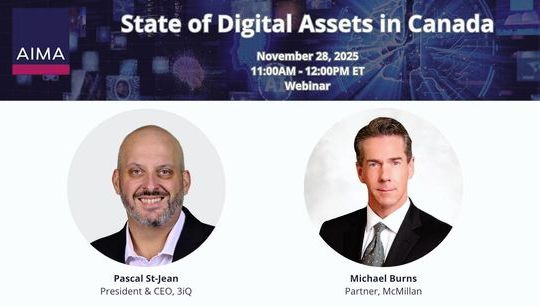On the Crypto Education Journey… Observations from the AIMA Digital Assets Conference
By Cathleen M. Rittereiser
Published: 16 June 2022
As a long-time member of the alternative investment community - as a capital-raiser, author, and speaker working with institutional allocators - when I started my crypto education journey, I turned to AIMA for guidance. AIMA has taken the lead in educating and organizing the digital asset investment ecosystem, much like they did with the global hedge fund industry over 30 years ago. Michelle Noyes, Managing Director, Americas for AIMA, started observing AIMA’s hedge fund members shift into digital assets around 2017 and began educating herself in order to educate and support members. She shared resources like books, courses, and videos, and even helped me set up a wallet and mint an NFT.
For the next step in my educational journey, I recently attended the inaugural AIMA Digital Assets Conference in New York City, a program that included information for every element of the process and for each key constituent in the hedge fund and digital assets ecosystem, including allocators, managers, operations, compliance professionals and service providers. I experienced the one-day conference as a microcosm of a larger journey. As a chronicler of how institutional allocators came to approach hedge funds, I was curious to see how the adoption curve was similar – or not – in digital assets.
Setting out with guides, attendees got a view of the current landscape. Then we “chose our own adventure”, selecting tracks based on our roles and interests, and ending with a regulatory reality check and view of the road ahead. As much as I wanted to attend every session, I chose the allocator track, learning about the opportunities in digital assets, tempered by an understanding of the risks and how to mitigate them.
Below I share my impressions, observations, and lessons, following the conference’s Chatham House Rule. Whatever your role is in the industry and wherever you are in your crypto/defi educational journey, I hope this will be a helpful guide.
Setting Out with Your Guides
John D'Agostino, Coinbase Institutional Lead for Advisory and Strategic Partnerships and the founder of the Digital Assets Working group (DAWG), and Michelle Noyes, Managing Director, Head of Americas, AIMA jointly kicked off the conference. Noyes explained how AIMA started seeing hedge fund members gravitating to digital assets and observed parallels to the early days of hedge funds. AIMA combined forces with DAWG to form a working group that is now 300 strong and focused on all aspects of making digital assets understandable and workable for institutional managers and asset owners. Topics they are covering and writing guides about include custody, audit, crypto due diligence (with a standard DDQ to come soon), trading and execution.
The conference occurred at an inflection point in industry history. It was the first in-person AIMA event in New York City in the two years since the Covid-19 pandemic began, and people were excited to be together. It occurred as Bitcoin and other digital assets had dropped in value to lows that hadn’t been seen in years and as the Terra/Luna (UST) crash was happening. It occurred as Traditional Finance professionals and allocators (TradFi) were awakening to the opportunities presented by blockchain technologies and digital assets (Decentralized Finance or DeFi). And it occurred as the alternative investment ecosystem was moving away from asking “What?” and “Why” and toward asking “How?”.
That last question, “How?” is what the conference was designed to answer. First, a look at the current landscape.
The Current Landscape from a Pioneering Asset Manager’s Perspective
Eric Peters, the Founder and CIO of One River Asset Management, participated in an opening fireside chat with John D’Agostino. Peters, a traditional macro hedge fund manager, has been a pioneer in investing in digital assets. Peters and D’Agostino began their chat as UST, a stablecoin, was melting down, but as a manager with institutional clients, he conveyed and encouraged a long-term view. To hear more from Peters, listen to his AIMA podcast available here.
The Current Landscape from Allocators’ Perspectives
Allocators are entering the digital assets space, primarily through their venture capital allocations, but that is starting to shift.
Given the massive technological changes on the horizon - spurred by developments in blockchain technology and fueled by capital flows - allocators can think of their crypto investments as an investment in both innovation and preparation for the changes to come.
One organization is making crypto a major part of its portfolio and aiming to find and fund a collection of the best quality builders in the space. They believe they can capture the most value with early stage investing and spend the bulk of their time working to secure early access to managers. One is taking a hybrid approach, investing in venture capital as part of a directional pool and in DeFi digital yield strategies in an absolute return pool.
While allocators currently seem to see Venture Capital as a less risky asset class than liquid crypto hedge funds, one commented that investing with traditional top tier VCs may not provide much of an advantage. Given the trajectory of crypto companies, which tend to go from pre-seed to seed to series A to a token offering, “What traditional VCs provide, these crypto companies don’t need.”
Hedge fund specialist allocators don’t have the option to invest in venture managers, but as the market has continued to mature and infrastructure has improved, they are beginning to make allocations. Ways to allocate include investing through traditional institutional hedge managers that have crypto offerings as well as in crypto native managers. Specific strategy opportunities include crypto relative value and directional. When assessing the crypto capabilities of traditional hedge fund managers, panelists were most comfortable with macro and arb specialists, but are gravitating toward dedicated crypto native managers. Rising rates, fees and structural issues, and constituent resistance, may slow the pace of allocation.
When it comes to getting buy-in from other stakeholders in the decision, such as boards, legal teams, and even clients, allocators recommended a few tactics. Education via use cases worked for one. Demonstrating that the metaverse is just a form of entertainment or that blockchain will reduce costs and improve speeds, helped dispel myths and doubt. Another allocator relies on pattern recognition and highlights the parallel trajectories of the hedge fund industry in the early 1990s and crypto today. Creating an internal research hub and sharing information with other members of the team is another way to level the knowledge field and bring others up the decision curve.
Allocators can mitigate risk by sizing the portfolio properly, remaining cognizant of unknowns, and becoming savvy about the technology. Or, they can mitigate risk by expecting and embracing it. Expect more complications, more protocols, more changes.
Panelists think there will be a couple of winners in each of the early categories of companies, such as exchanges, storage, and wallets. With that in mind, one allocator said, “Get exposure to the wild and crazy, because it’s less crowded.”
Allocators predict there will be the ability to monetize intellectual property through smart contracts and an ability to own the companies you buy from. Businesses will find different ways to add value and there will be interesting ways to be rewarded. Allocators that are early in their journey may want to begin to engage in defi communities and prepare for self-custody.
Allocator Track: Finding and Evaluating Opportunities, Understanding and Mitigating Risks
On the allocator track, I heard from a mix of top managers, consultants and advisors, and service providers. They described opportunities and helped participants understand and mitigate risks.
Venture Capital
The tech world is going through generational change - a mega reset - driven by developments in crypto and digital assets. As more organizations and more talent move into the space there remains a need to build infrastructure. VC continues to be an area of opportunity, and a global one at that, with Asia highlighted as an opportunity.
Again, traditional VCs may no longer have advantages they enjoy in traditional finance, because the best deals tend to go to crypto native VCs. Additionally, one cannot compare crypto valuations apples-to-apples to equity valuations in startups. Many crypto investments are token deals with a shorter time horizon than typical venture capital.
When evaluating a potential investment in a crypto native VC, many of the same rules still apply. An allocator must judge the ability of the VC’s team and understand the VC’s strategy. For instance, is it a “Pokémon” catch-all strategy or is it one based in “First Principles''? Consider the VC’s exit strategy and how it aligns with yours. Is the VC thoughtful about harvesting liquidity? Exits are often realized in tokens. While they can be offered in kind, the panelists believed that over time, institutions will be comfortable taking tokens directly.
Hedge Funds
Allocators are “seeing an interesting range of opportunities every day, each with their own dynamics.” Traditional hedge fund managers, especially macro and multi-strat managers, have offered digital sleeves or individual digital strategies, but now more specialized digital asset hedge funds, such as market neutral strategies, and digital yield funds are coming into the market.
Directional digital assets funds: One manager says it’s possible to manage directional exposure and achieve a higher Sharpe ratio by vetting tokens properly and managing risk to dampen volatility. Because the tokens are all very different from each other, it is important for the manager to understand protocols, governance, and value. In particular, the manager must understand the underlying tech.
Digital Yield hedge funds: This category has grown so much it had its own breakout session, and it seems like these funds could serve as another form of alternative credit. It was the most challenging session for my existing knowledge level, so it helped me see where I need to conduct more research. Digital yield funds will be important for institutional allocators to prioritize and learn more.
When assessing the risks of digital asset hedge funds, allocators need to understand the investment risks, the operational risks, and importantly, the technical risks. For the latter, it’s understanding the technical aspects of the protocols or the smart contract risks.
Allocators need to develop new capabilities and prepare for new lines of questioning, or prepare to bring in outside advisors like consultants or funds of funds. Some questions to consider when preparing to allocate to digital asset funds include:
- What is the manager doing? How is it congruent with their capabilities?
- What are the metrics we should use to evaluate these managers?
- How do new innovations in protocols work? How could they fail?
- What ripples and disruptions should I anticipate if a protocol fails? How would I prepare?
Finally, allocators should expect to see continued innovation among service providers, including separately managed accounts and the availability of capital introduction services. Custody solutions are still coming into the market, and one panelist mentioned the need for 24/7 settlement as crypto trades all day.
Operational Due Diligence
Because investors are not compensated for taking on operational risk, ODD professionals focus on identifying and evaluating these non-investment risks such as valuations, custody, counterparty, asset liability mismatches, and cybersecurity. The panelists made it clear that ODD is not intended to be an adversarial process, but a tool to make informed decisions about a manager. While they see similar operational risks between hedge funds and crypto/ defi strategies, there are differences they’re working to understand and overcome.
They are contending with a different ecosystem of managers and a whole new set of service providers and experiencing new types of counterparty exposures and custody protocols. For instance, custody with a hardware wallet raises issues about how passwords are being protected. Immutable databases have the potential to create problems when there are errors. They lack standardized data.
All are trying to establish best practices while managing an accelerating pace of change. Given their objective to help their colleagues or clients work with talented managers, they try to remain flexible, particularly when managers are innovating in the operational side of their business. Crypto ODD is going to be an ongoing learning process that requires good two-way communication, honesty, transparency, and documentation. They acknowledged that various AIMA working groups and industry guides are helping.
Regulatory Reality Check
There were worries the SEC focuses too much on crypto enforcement and not enough on crypto regulation. Most crypto organizations are seeking to comply with clear regulations, and firms are encouraged to bring their plans and use cases to regulators to facilitate innovative, effective regulation.
The Road Ahead
The conference closed with views of what the future might hold. All were excited about rapid innovation and the opportunities presented by Web3 technologies. Web3 promises to be a true peer-to-peer system, with the potential to create an ownership economy and the ability “to own things we never thought we could.” The intersection of technology and content creates new ways to earn and interact.
Portable identity is one area of opportunity. Today gaming participants develop identities and earn points and tokens in several virtual places, but they want to move seamlessly from one platform to another. There are also opportunities to build infrastructure, data and analytics, and interoperability.
Web3 is about building a bigger pie, creating more value, and providing more economic opportunity.
Moving Forward into the Future
During the opening session, Noyes and D’Agostino showed a quick video demonstrating the “what” and “why” of digital assets. In the video, a charming young woman, a member of the Stamford High School Blockchain Club, explained blockchain to Noyes’s and D’Agostino’s mothers. She not only taught them, but she made a compelling case for why the future belongs to those that choose to create it and live in it. I thought of that William Gibson quote. “The future is already here – it's just not evenly distributed.” The excitement, momentum, potential, possibility, and reality permeating the conference makes me say that the future is just not evenly distributed YET.
###

Cathleen M. Rittereiser is an alternative investments business development and marketing professional, the co-author of the books Foundation and Endowment Investing and Top Hedge Fund Investors, and founder of the Uncorrelated investment forums.









